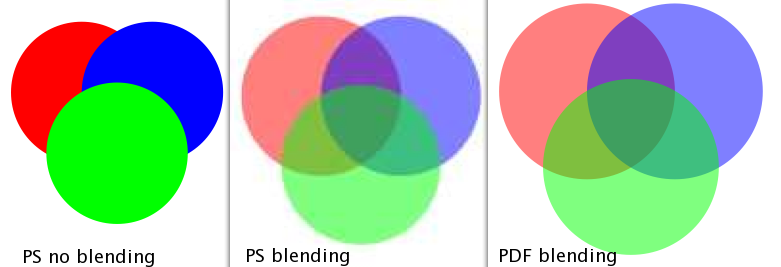Cairo PostScript rendering
I am trying to render vector graphics with alpha blending. Too bad, PostScript, even Level 3, does not support alpha blending. This means that if you want to draw two objects (say, circles) in PostScript and you want to make them look as they are alpha blended you have to do "some" trick. An example:
- draw the first, then the second object (which will overlap and overwrite the first) with proper colors (considering the background color)
- calculate the intersection between the two areas
- calculate the blended color, considering the transparency level of the two and the background color
- draw the intersection part with the blended color
This of course gets more and more complex as more objects overlap along the z-axis (say, a line, a circle, two rectangles and a spline curve). For all of them you have to consider the stacking, how they overlap, decompose the overlapping parts properly, compute the proper colors of each intersecting region, draw all the parts in the proper order (so they stack properly when rendered). This is not trivial.
For this reason, I was considering Cairo, assuming that they solved this problem. After a little tinkering I found out that even Cairo gives up in rendering PostScript vector graphics with alpha blending. For example, this code draws non-blended circles (alpha = 1.0), producing a vector based PostScript
int main (int argc, char *argv[]) {
cairo_surface_t *surface;
cairo_t *cr;
char *filename = "image.ps";
surface = (cairo_surface_t *)cairo_ps_surface_create (filename, 80.0, 80.0);
cr = cairo_create (surface);
cairo_set_source_rgba (cr, 1.0, 0.0, 0.0, 1.0);
cairo_set_line_width (cr, 1.0);
cairo_set_fill_rule (cr, CAIRO_FILL_RULE_WINDING);
cairo_arc(cr, 20.0, 20.0, 10.0, 0.0, 2*M_PI);
cairo_fill(cr);
cairo_stroke (cr);
cairo_set_source_rgba (cr, 0.0, 0.0, 1.0, 1.0);
cairo_arc(cr, 30.0, 20.0, 10.0, 0.0, 2*M_PI);
cairo_fill(cr);
cairo_stroke (cr);
cairo_set_source_rgba (cr, 0.0, 1.0, 0.0, 1.0);
cairo_arc(cr, 25.0, 28.6, 10.0, 0.0, 2*M_PI);
cairo_fill(cr);
cairo_stroke (cr);
cairo_destroy (cr);
cairo_surface_destroy (surface);
return 0;
}
However, if you replace
cairo_set_source_rgba (cr, 1.0, 0.0, 0.0, 1.0);
with
cairo_set_source_rgba (cr, 1.0, 0.0, 0.0, 0.5);
consequently enabling the need for alpha blending, things change. The final PostScript file contains a rastered image, not a vector representation. If you render it using the PDF backend, the image contains vector-based graphics with blending. I'm not really into the PDF format, but this fact hints at native alpha blending support.
The picture show the three different cases. From left to right, PostScript backend without alpha blending, PostScript backend with alpha blending, and PDF backend with alpha blending.

The PDF output was obtained by changing the line
surface = (cairo_surface_t *)cairo_ps_surface_create (filename, 80.0, 80.0);
to
surface = (cairo_surface_t *)cairo_pdf_surface_create (filename, 80.0, 80.0);
and of course changing also the file name accordingly. Please note that both PostScript images were converted to PDF using ps2pdf before being displayed: due to some setup problems on my mac, I am not able to open PostScript files directly (which are converted by Preview.app to PDF anyway). This however does not affect the conclusion, which is also confirmed by peeking into the generated PostScript files with an editor.
The raster, quite low quality nature of the PostScript with alpha blending is evident. Apparently, Cairo renders what looks like a JPEG image, and then includes it using DataSource (See PostScript reference manual, Section 4.10).
Concluding, from my findings it looks like Cairo is not able produce a PostScript vectorial representation containing alpha blending. It must resort to a raster representation, therefore losing all the advantages of a vector format.
Despite this, I think Cairo is a very nice and powerful library to render vector graphics in a programmatic way. Kudos to the implementors!